Fabrication-Aware Synthetic Dataset Generation and Compact Geometric Encoding for Architectural Robotic Assembly of Brick Wall Designs
Abstract
1. Introduction
- A six-stage synthetic data creation pipeline that integrates parametric modeling, algorithmic pattern generation, real-time physics simulation, and robotic toolpath generation for fabrication-aware brick wall designs.
- A domain-specific geometric encoding strategy based on dot-product transformations, enabling dimensionality reduction while retaining essential orientation information for ML-based predictive or generative applications.
- A comparative evaluation of sampling strategies (brute-force vs. stochastic sampling) assessed using entropy metrics, PCA, t-SNE embeddings, and nearest-neighbor distance analyses to quantify dataset diversity and redundancy.
- Physical assessment of selected designs via robotic assembly, highlighting discrepancies between simulation and reality, and identifying opportunities for feedback loops and tolerance-aware robotic control systems.
2. Literature Review
2.1. Dataset Limitations in Architectural Robotic Fabrication Research
2.2. Alternative Approaches in Integrating DL in Generative Design for Robotic Fabrication
2.3. Bridging the Gap with Constraint-Aware Synthetic Data
3. Materials and Methods
3.1. Data Requirements for Robotic Assembly
3.2. Dataset Framework for Machine Learning
3.3. Computer Setup
3.4. Workflow for Data Generation and Physical Assessment
- parametric modeling
- design generation
- physics simulation
- data storage
- robotic toolpath generation
- robotic assembly
3.5. Characteristics and Details of Wall Data
- (1)
- Full Geometric Representation:
- (2)
- Grayscale Encoding Based on Rotation:
- (3)
- Dot Product-Based Rotation Encoding:
4. Results and Analysis
4.1. Quantitative Analysis of the Datasets
4.1.1. Description of the Synthetic Datasets
4.1.2. Nearest-Neighbor Distance Analysis Between Sampling Methods
4.1.3. Entropy Analysis
4.1.4. Dimensionality Reduction and Distributional Comparison of Sampling Strategies
4.2. Evaluation of the Dataset
4.3. Robotic Assembly
5. Discussion
5.1. Fabrication-Aware Parametric Modeling
5.2. Evaluation of Data Sampling Strategies
5.3. Structural Performance Insights from the Datasets
5.4. Simulation vs. Reality: Insights and Limitations
5.5. Generalization Potential and AI Learning Utility
5.6. Limitations and Future Research
6. Conclusions
Author Contributions
Funding
Data Availability Statement
Acknowledgments
Conflicts of Interest
Abbreviations
| AI | Artificial Intelligence |
| ANN | Artificial Neural Network |
| AUC | Area Under the Curve |
| CSV | Comma Separated Values |
| DL | Deep Learning |
| GAN | Generative Adversarial Networks |
| GenAI | Generative Artificial Intelligence |
| IDW | Inverse Distance Weighting |
| ML | Machine Learning |
| PCA | Principal Component Analysis |
| ReLU | Rectified Linear Unit |
| RL | Reinforcement Learning |
| ROC | Receiver Operating Characteristic |
| t-SNE | t-distributed Stochastic Neighbor Embedding |
| UR | Universal Robot |
| VAE | Variational Autoencoder |
References
- Goodfellow, I.J.; Pouget-Abadie, J.; Mirza, M.; Xu, B.; Warde-Farley, D.; Ozair, S.; Courville, A.; Bengio, Y. Generative Adversarial Nets. In Proceedings of the Advances in Neural Information Processing Systems 27, Montreal, QC, Canada, 8–13 December 2014. [Google Scholar]
- Kingma, D.P.; Welling, M. Auto-encoding variational bayes. arXiv 2013, arXiv:1312.6114. [Google Scholar]
- Ho, J.; Jain, A.; Abbeel, P. Denoising diffusion probabilistic models. In Proceedings of the Advances in Neural Information Processing Systems 33, Virtual, 6–12 December 2020. [Google Scholar]
- Nauata, N.; Hosseini, S.; Chang, K.H.; Chu, H.; Cheng, C.Y.; Furukawa, Y. House-GAN++: Generative Adversarial Layout Refinement Network towards Intelligent Computational Agent for Professional Architects. In Proceedings of the IEEE/CVF Conference on Computer Vision and Pattern Recognition (CVPR), Nashville, TN, USA, 20–25 June 2021. [Google Scholar]
- Aalaei, M.; Saadi, M.; Rahbar, M.; Ekhlassi, A. Architectural layout generation using a graph-constrained conditional Generative Adversarial Network (GAN). Autom. Constr. 2023, 155, 105053. [Google Scholar] [CrossRef]
- Lu, Z.; Li, Y.; Wang, F. Complex layout generation for large-scale floor plans via deep edge-aware GNNs. Appl. Intell. 2025, 55, 400. [Google Scholar] [CrossRef]
- Peng, Z.; Zhang, Y.; Lu, W.; Li, X. Data-driven generative contextual design model for building morphology in dense metropolitan areas. Autom. Constr. 2024, 168, 105820. [Google Scholar] [CrossRef]
- Liu, Y.; Li, H.; Deng, Q.; Hu, K. Diffusion Probabilistic Model Assisted 3D Form Finding and Design Latent Space Exploration: A Case Study for Taihu Stone Spacial Transformation; Springer Nature: Singapore, 2024. [Google Scholar]
- Li, C.; Zhang, T.; Du, X.; Zhang, Y.; Xie, H. Generative AI models for different steps in architectural design: A literature review. Front. Archit. Res. 2025, 14, 759–783. [Google Scholar] [CrossRef]
- Yu, Q.; Malaeb, J.; Ma, W. Architectural Facade Recognition and Generation through Generative Adversarial Networks. In Proceedings of the 2020 International Conference on Big Data & Artificial Intelligence & Software Engineering (ICBASE), Chengdu, China, 23–25 October 2020. [Google Scholar]
- Sun, C.; Zhou, Y.; Han, Y. Automatic generation of architecture facade for historical urban renovation using generative adversarial network. Build. Environ. 2022, 212, 108781. [Google Scholar] [CrossRef]
- Law, S.; Valentine, C.; Kahlon, Y.; Seresinhe, C.I.; Tang, J.; Morad, M.G.; Fujii, H. Generative AI for Architectural Façade Design: Measuring Perceptual Alignment Across Geographical, Objective, and Affective Descriptors. Buildings 2025, 15, 3212. [Google Scholar] [CrossRef]
- Fui-Hoon Nah, F.; Zheng, R.; Cai, J.; Siau, K.; Chen, L. Generative AI and ChatGPT: Applications, challenges, and AI-human collaboration. J. Inf. Technol. Case Appl. Res. 2023, 25, 277–304. [Google Scholar] [CrossRef]
- Zhang, W.; Li, H.; Li, Y.; Liu, H.; Chen, Y.; Ding, X. Application of deep learning algorithms in geotechnical engineering: A short critical review. Artif. Intell. Rev. 2021, 54, 5633–5673. [Google Scholar] [CrossRef]
- Luo, D.; Xu, W. Adaptable Method for Dynamic Planning of 3D Spatial Wireframes Extrusion with Neural Networks and Robotic Automation. 3D Print. Addit. Manuf. 2022, 9, 255–268. [Google Scholar] [CrossRef] [PubMed]
- Tsuruta, K.; Griffioen, S.J.; Ibáñez, J.M.; Johns, R.L. Deep Sandscapes: Design Tool for Robotic Sand-Shaping with GAN-Based Heightmap Predictions. In Proceedings of the 2022 Annual Modeling and Simulation Conference (ANNSIM), San Diego, CA, USA, 18–20 July 2022. [Google Scholar]
- Greff, K.; Belletti, F.; Beyer, L.; Doersch, C.; Du, Y.; Duckworth, D.; Fleet, D.J.; Gnanapragasam, D.; Golemo, F.; Herrmann, C.; et al. Kubric: A scalable dataset generator. In Proceedings of the IEEE/CVF Conference on Computer Vision and Pattern Recognition, New Orleans, LA, USA, 18–24 June 2022. [Google Scholar]
- Deng, J.; Dong, W.; Socher, R.; Li, L.J.; Li, K.; Fei-Fei, L. ImageNet: A large-scale hierarchical image database. In Proceedings of the 2009 IEEE Conference on Computer Vision and Pattern Recognition, Miami Beach, FL, USA, 20–25 June 2009. [Google Scholar]
- Baack, S. A Critical Analysis of the Largest Source for Generative AI Training Data: Common Crawl. In Proceedings of the 2024 ACM Conference on Fairness, Accountability, and Transparency, Rio de Janeiro, Brazil, 3–6 June 2024; Association for Computing Machinery: New York, NY, USA; pp. 2199–2208. [Google Scholar]
- Wu, K.; Kilian, A. Designing Natural Wood Log Structures with Stochastic Assembly and Deep Learning. In Robotic Fabrication in Architecture, Art and Design 2018; Springer International Publishing: Cham, Switzerland, 2019. [Google Scholar]
- Fragkia, V.; Foged, I.W.; Pasold, A. Predictive Information Modeling: Machine Learning Strategies for Material Uncertainty. Technol. Archit. Des. 2021, 5, 163–176. [Google Scholar] [CrossRef]
- Ali, A.K.; Lee, O.J.; Song, H. Robot-based facade spatial assembly optimization. J. Build. Eng. 2021, 33, 101556. [Google Scholar] [CrossRef]
- Leng, J.; Zuo, K.; Xu, C.; Zhou, X.; Zheng, S.; Kang, J.; Liu, Q.; Chen, X.; Shen, W.; Wang, L.; et al. Physics-informed machine learning in intelligent manufacturing: A review. J. Intell. Manuf. 2025. [Google Scholar] [CrossRef]
- Wu, Y.; Sicard, B.; Gadsden, S.A. Physics-informed machine learning: A comprehensive review on applications in anomaly detection and condition monitoring. Expert Syst. Appl. 2024, 255, 124678. [Google Scholar] [CrossRef]
- Xu, Y.; Kohtz, S.; Boakye, J.; Gardoni, P.; Wang, P. Physics-informed machine learning for reliability and systems safety applications: State of the art and challenges. Reliab. Eng. Syst. Saf. 2023, 230, 108900. [Google Scholar] [CrossRef]
- Gharbia, M.; Chang-Richards, A.; Lu, Y.; Zhong, R.Y.; Li, H. Robotic technologies for on-site building construction: A systematic review. J. Build. Eng. 2020, 32, 101584. [Google Scholar] [CrossRef]
- Dörfler, K.; Sandy, T.; Giftthaler, M.; Gramazio, F.; Kohler, M.; Buchli, J. Mobile Robotic Brickwork: Automation of a Discrete Robotic Fabrication Process Using an Autonomous Mobile Robot. In Robotic Fabrication in Architecture, Art and Design 2016; Reinhardt, D., Saunders, R., Burry, J., Eds.; Springer International Publishing: Cham, Switzerland, 2016; pp. 204–217. [Google Scholar]
- Piškorec, L.; Jenny, D.; Parascho, S.; Mayer, H.; Gramazio, F.; Kohler, M. The Brick Labyrinth. In Robotic Fabrication in Architecture, Art and Design 2018; Springer International Publishing: Cham, Switzerland, 2019. [Google Scholar]
- de Melo, C.M.; Torralba, A.; Guibas, L.; DiCarlo, J.; Chellappa, R.; Hodgins, J. Next-generation deep learning based on simulators and synthetic data. Trends Cogn. Sci. 2022, 26, 174–187. [Google Scholar] [CrossRef]
- Gräßler, I.; Hieb, M. Creating Synthetic Datasets for Deep Learning used in Machine Vision. Procedia CIRP 2024, 126, 981–986. [Google Scholar] [CrossRef]
- Boikov, A.; Payor, V.; Savelev, R.; Kolesnikov, A. Synthetic Data Generation for Steel Defect Detection and Classification Using Deep Learning. Symmetry 2021, 13, 1176. [Google Scholar] [CrossRef]
- Paproki, A.; Salvado, O.; Fookes, C. Synthetic Data for Deep Learning in Computer Vision & Medical Imaging: A Means to Reduce Data Bias. ACM Comput. Surv. 2024, 56, 271. [Google Scholar] [CrossRef]
- Wong, M.Z.; Kunii, K.; Baylis, M.; Ong, W.H.; Kroupa, P.; Koller, S. Synthetic dataset generation for object-to-model deep learning in industrial applications. PeerJ Comput. Sci. 2019, 5, e222. [Google Scholar] [CrossRef]
- Rafizadeh, H.; Teixeira, M.F.L.A.; Donovan, J.; Schork, T. BrickNet: A computational design framework for robust dataset creation for robotic fabrication and design automation. In Architectural Informatics, Proceedings of the 30th International Conference of the Association for Computer-Aided Architectural Design Research in Asia (CAADRIA) 2025, Tokyo, Japan, 26–28 March 2025; The Association for Computer-Aided Architectural Design Research in Asia: Hong Kong, China, 2025; Volume 2. [Google Scholar]
- Wu, W.; Fu, X.M.; Tang, R.; Wang, Y.; Qi, Y.H.; Liu, L. Data-driven interior plan generation for residential buildings. ACM Trans. Graph. 2019, 38, 234. [Google Scholar] [CrossRef]
- Kalervo, A.; Ylioinas, J.; Häikiö, M.; Karhu, A.; Kannala, J. CubiCasa5K: A Dataset and an Improved Multi-task Model for Floorplan Image Analysis. In Image Analysis; Springer International Publishing: Cham, Switzerland, 2019. [Google Scholar]
- Zheng, J.; Zhang, J.; Li, J.; Tang, R.; Gao, S.; Zhou, Z. Structured3D: A Large Photo-Realistic Dataset for Structured 3D Modeling; Springer International Publishing: Cham, Switzerland, 2020. [Google Scholar]
- Chen, X.; Xiong, Y.; Wang, S.; Wang, H.; Sheng, T.; Zhang, Y.; Ye, Y. ReCo: A Dataset for Residential Community Layout Planning. In Proceedings of the 31st ACM International Conference on Multimedia, Ottawa, ON, Canada, 29 October–2 November 2023; Association for Computing Machinery: New York, NY, USA; pp. 397–405. [Google Scholar]
- Park, H.; Gu, H.; Hong, S.; Choo, S. Developing a Robust Training Dataset for AI-Driven Architectural Spatial Layout Generation. Appl. Sci. 2024, 14, 7095. [Google Scholar] [CrossRef]
- Ramsgaard Thomsen, M.; Nicholas, P.; Tamke, M.; Gatz, S.; Sinke, Y.; Rossi, G. Towards machine learning for architectural fabrication in the age of industry 4.0. Int. J. Archit. Comput. 2020, 18, 335–352. [Google Scholar] [CrossRef]
- Tamke, M.; Nicholas, P.; Zwierzycki, M. Machine learning for architectural design: Practices and infrastructure. Int. J. Archit. Comput. 2018, 16, 123–143. [Google Scholar] [CrossRef]
- Das, A.R.; Koskinopoulou, M. Toward Sustainable Manufacturing: A Review on Innovations in Robotic Assembly and Disassembly. IEEE Access 2025, 13, 100149–100166. [Google Scholar] [CrossRef]
- Belousov, B.; Wibranek, B.; Schneider, J.; Schneider, T.; Chalvatzaki, G.; Peters, J.; Tessmann, O. Robotic architectural assembly with tactile skills: Simulation and optimization. Autom. Constr. 2022, 133, 104006. [Google Scholar] [CrossRef]
- Sebestyen, A.; Hirschberg, U.; Rasoulzadeh, S. Using deep learning to generate design spaces for architecture. Int. J. Archit. Comput. 2023, 21, 337–357. [Google Scholar] [CrossRef]
- Akizuki, Y.; Bernhard, M.; Kladeftira, M.; Kakooee, R.; Dillenburger, B. Generative modelling with design constraints–reinforcement learning for object generation. In Proceedings of the RE: Anthropocene, Design in the Age of Humans–Proceedings of the 25th CAADRIA Conference, Bangkok, Thailand, 5–6 August 2020; Association for Computer Aided Architectural Design Research in Asia: Hong Kong, China, 2020. [Google Scholar]
- Wang, D.; Snooks, R. Artificial Intuitions of Generative Design: An Approach Based on Reinforcement Learning. In Proceedings of the 2020 DigitalFUTURES; Springer: Singapore, 2021. [Google Scholar]
- Li, Y.; Kong, T.; Li, L.; Li, Y.; Wu, Y. Learning to Design and Construct Bridge without Blueprint. In Proceedings of the 2021 IEEE/RSJ International Conference on Intelligent Robots and Systems (IROS), Online, 27 September–1 October 2021. [Google Scholar]
- Felbrich, B.; Schork, T.; Menges, A. Autonomous robotic additive manufacturing through distributed model-free deep reinforcement learning in computational design environments. Constr. Robot. 2022, 6, 15–37. [Google Scholar] [CrossRef]
- Vallat, G.; Wang, J.; Maddux, A.; Kamgarpour, M.; Parascho, S. Reinforcement learning for scaffold-free construction of spanning structures. In Proceedings of the 8th ACM Symposium on Computational Fabrication, New York, NY, USA, 8–10 October 2023; Association for Computing Machinery: New York, NY, USA, 2023; p. 12. [Google Scholar]
- Hosna, A.; Merry, E.; Gyalmo, J.; Alom, Z.; Aung, Z.; Azim, M.A. Transfer learning: A friendly introduction. J. Big Data 2022, 9, 102. [Google Scholar] [CrossRef]
- Cacciarelli, D.; Kulahci, M. Active learning for data streams: A survey. Mach. Learn. 2024, 113, 185–239. [Google Scholar] [CrossRef]
- Wang, Y.; Yao, Q.; Kwok, J.T.; Ni, L.M. Generalizing from a Few Examples: A Survey on Few-shot Learning. ACM Comput. Surv. 2020, 53, 63. [Google Scholar] [CrossRef]
- Zhang, Y.; Yang, Q. A Survey on Multi-Task Learning. IEEE Trans. Knowl. Data Eng. 2022, 34, 5586–5609. [Google Scholar] [CrossRef]
- Gangwal, A.; Ansari, A.; Ahmad, I.; Azad, A.K.; Sulaiman, W.M.A.W. Current strategies to address data scarcity in artificial intelligence-based drug discovery: A comprehensive review. Comput. Biol. Med. 2024, 179, 108734. [Google Scholar] [CrossRef] [PubMed]
- Weber, M.; Banihashemi, F.; Mandl, P.; Jacobsen, H.A.; Mayer, R. Overcoming Data Scarcity through Transfer Learning in CO2-Based Building Occupancy Detection. In Proceedings of the 10th ACM International Conference on Systems for Energy-Efficient Buildings, Cities, and Transportation, Istanbul, Turkey, 15–16 November 2023; Association for Computing Machinery: New York NY, USA, 2023; pp. 1–10. [Google Scholar]
- Mitrano, P.; Berenson, D. Data augmentation for manipulation. arXiv 2022, arXiv:2205.02886. [Google Scholar]
- Trabucco, B.; Doherty, K.; Gurinas, M.; Salakhutdinov, R. Effective Data Augmentation With Diffusion Models. arXiv 2024, arXiv:2302.07944. [Google Scholar]
- Thomas, U.; Wahl, F.M. Assembly Planning and Task Planning—Two Prerequisites for Automated Robot Programming. In Robotic Systems for Handling and Assembly; Schütz, D., Wahl, F.M., Eds.; Springer: Berlin, Germany, 2011; pp. 333–354. [Google Scholar]
- Zhou, L.; Pan, S.; Wang, J.; Vasilakos, A.V. Machine learning on big data: Opportunities and challenges. Neurocomputing 2017, 237, 350–361. [Google Scholar] [CrossRef]
- Connolly, M.; Ramasubramanian, A.K.; Kelly, M.; McEvoy, J.; Papakostas, N. Realistic simulation of robotic grasping tasks: Review and application. Procedia CIRP 2021, 104, 1704–1709. [Google Scholar] [CrossRef]
- Mehdizadeh, S.; Tessmann, O. Roll-locks: A fabrication to self-assembly design-framework for reusable discrete concrete elements. In Advances in Architectural Geometry(AAG); DE Gruyter: Berlin, Germany, 2023. [Google Scholar]
- Song, Y.; Agkathid, A.; Koeck, R. Augmented Performative Design: A Workflow Utilizing Augmented Reality for Structurally Stable Masonry Design. In Computer-Aided Architectural Design. Interconnections: Co-Computing Beyond Boundaries; Springer Nature: Cham, Switzerland, 2023. [Google Scholar]
- Agkathidis, A.; Song, Y.; Zhao, J. Rethinking the Brick: Developing a File to Fabrication Framework for Mortar-Free, Robotic Masonry Wall Assembly. In Computational Design and Digital Manufacturing; Kyratsis, P., Manavis, A., Davim, J.P., Eds.; Springer International Publishing: Cham, Switzerland, 2023; pp. 107–118. [Google Scholar]
- Albaghajati, Z.M.; Bettaieb, D.M.; Malek, R.B. Exploring text-to-image application in architectural design: Insights and implications. Archit. Struct. Constr. 2023, 3, 475–497. [Google Scholar] [CrossRef]
- Gallego, E.; Fuentes, J.M.; Ruiz, Á.; Hernández-Rodrigo, G.; Aguado, P.; Ayuga, F. Determination of mechanical properties for wood pellets used in DEM simulations. Int. AgroPhys. 2020, 34, 485–494. [Google Scholar] [CrossRef]
- Maturo, F.; Rambaud, S.C.; Ventre, V. Advances in statistical learning from high-dimensional data. Qual. Quant. 2025, 59, 1933–1937. [Google Scholar] [CrossRef]
- Issa, R. Essential Mathematics for Computational Design, 4th ed.; Robert McNeel & Associates: Seattle, WA, USA, 2019; pp. 14–16. [Google Scholar]
- Abdi, H.; Williams, L.J. Principal component analysis. WIREs Comput. Stat. 2010, 2, 433–459. [Google Scholar] [CrossRef]
- Maaten, L.; Hinton, G. Visualizing data using t-SNE. J. Mach. Learn. Res. 2008, 9, 2579–2605. [Google Scholar]
- Atanasova, L.; Kenny, J.C.; Alexi, E.V.; Chovghi, F.; Mitterberger, D.; Dörfler, K. Building (with) human–robot teams: Fabrication-aware design, planning, and coordination of cooperative assembly processes. Constr. Robot. 2025, 9, 16. [Google Scholar] [CrossRef]
- Devadass, P.; Heimig, T.; Stumm, S.; Kerber, E.; Brell-Cokcan, S. Robotic constraints informed design process. In Proceedings of the 39th Annual Conference of the Association for Computer Aided Design in Architecture (ACADIA), Austin, TX, USA, 21–26 October 2019. [Google Scholar]
- Feng, C.; Xiao, Y.; Willette, A.; McGee, W.; Kamat, V.R. Vision guided autonomous robotic assembly and as-built scanning on unstructured construction sites. Autom. Constr. 2015, 59, 128–138. [Google Scholar] [CrossRef]
- Apolinarska, A.A.; Pacher, M.; Li, H.; Cote, N.; Pastrana, R.; Gramazio, F.; Kohler, M. Robotic assembly of timber joints using reinforcement learning. Autom. Constr. 2021, 125, 103569. [Google Scholar] [CrossRef]
- Roh, Y.; Heo, G.; Whang, S.E. A Survey on Data Collection for Machine Learning: A Big Data-AI Integration Perspective. IEEE Trans. Knowl. Data Eng. 2021, 33, 1328–1347. [Google Scholar] [CrossRef]
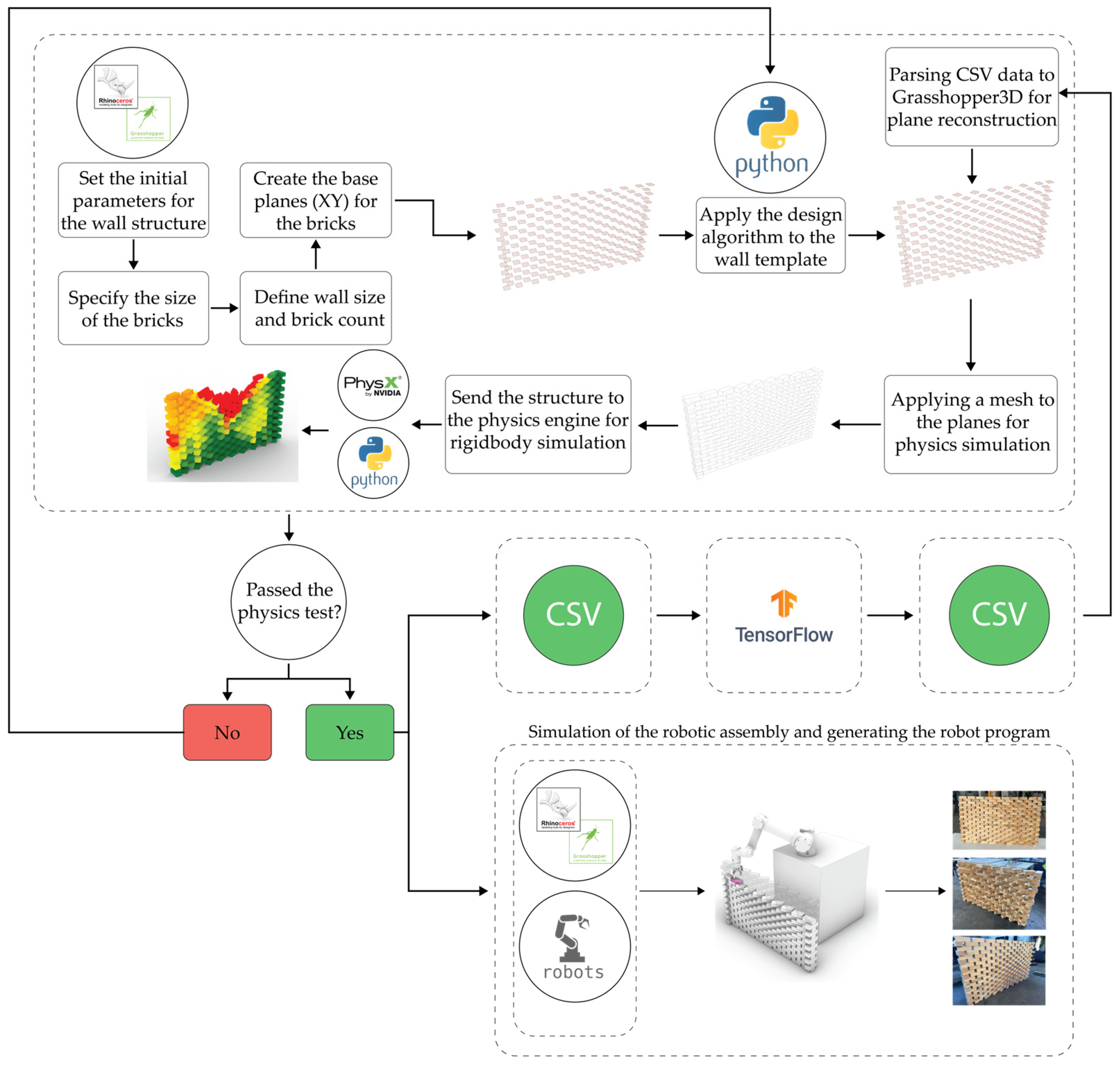
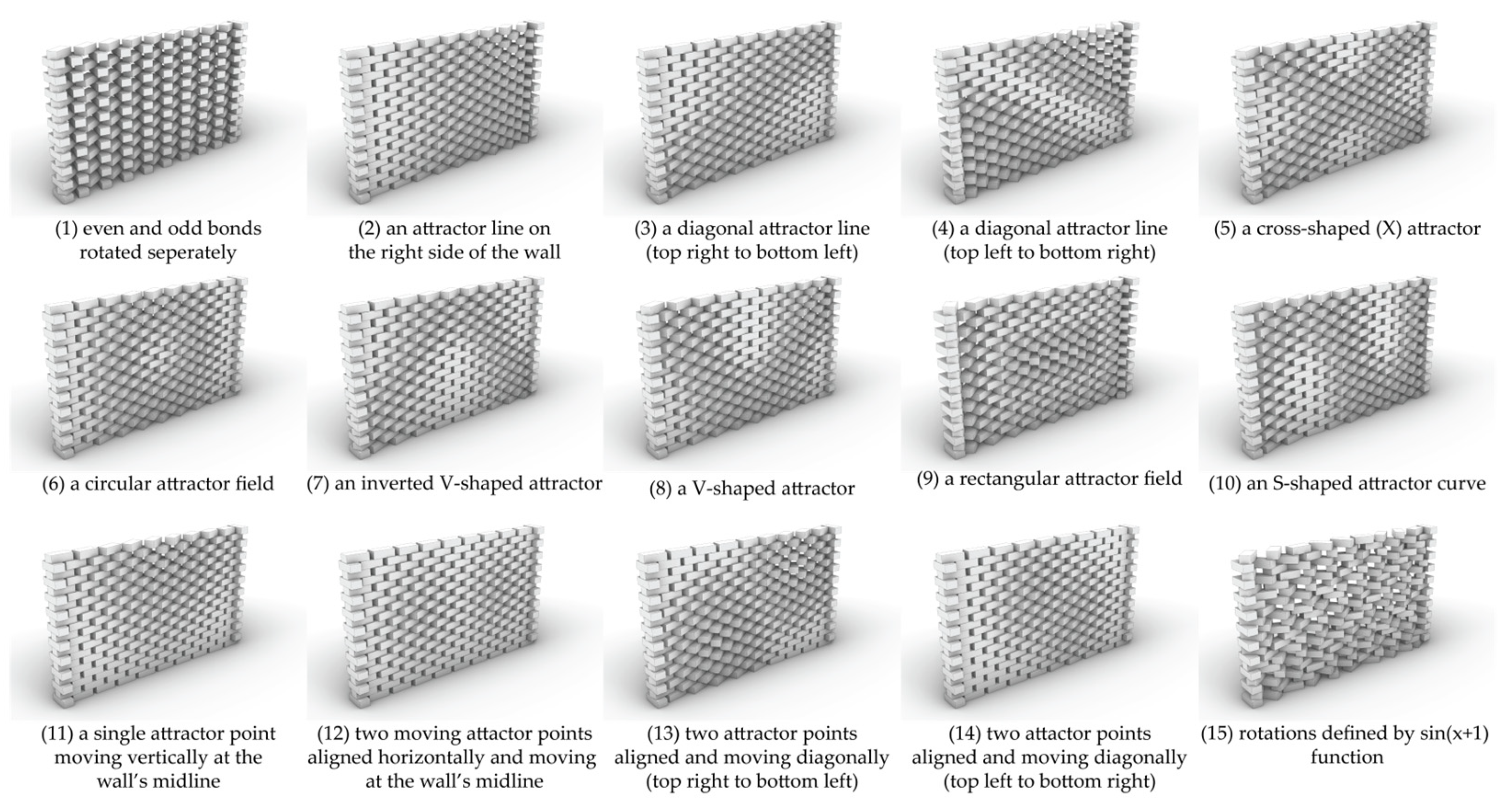
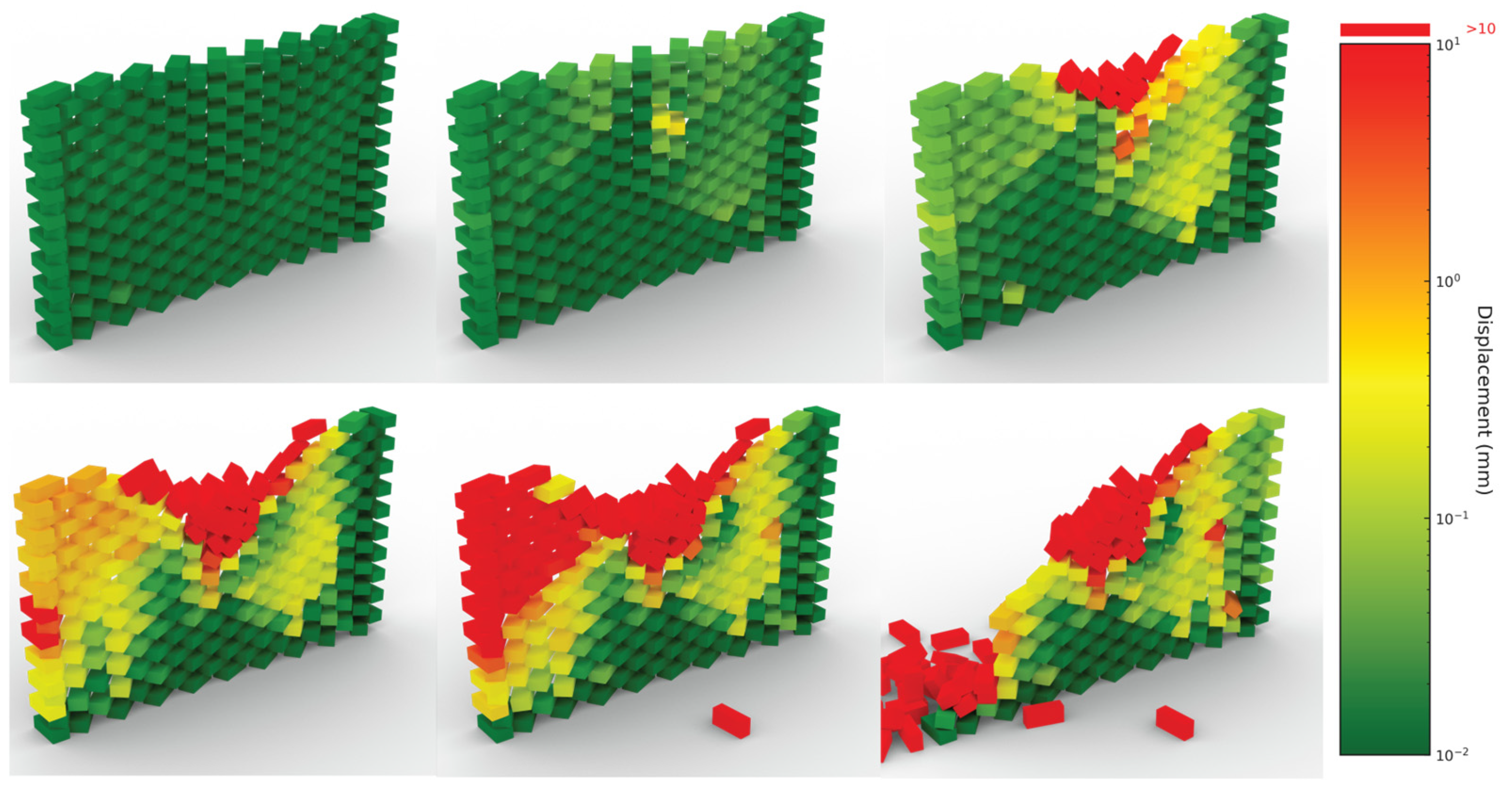
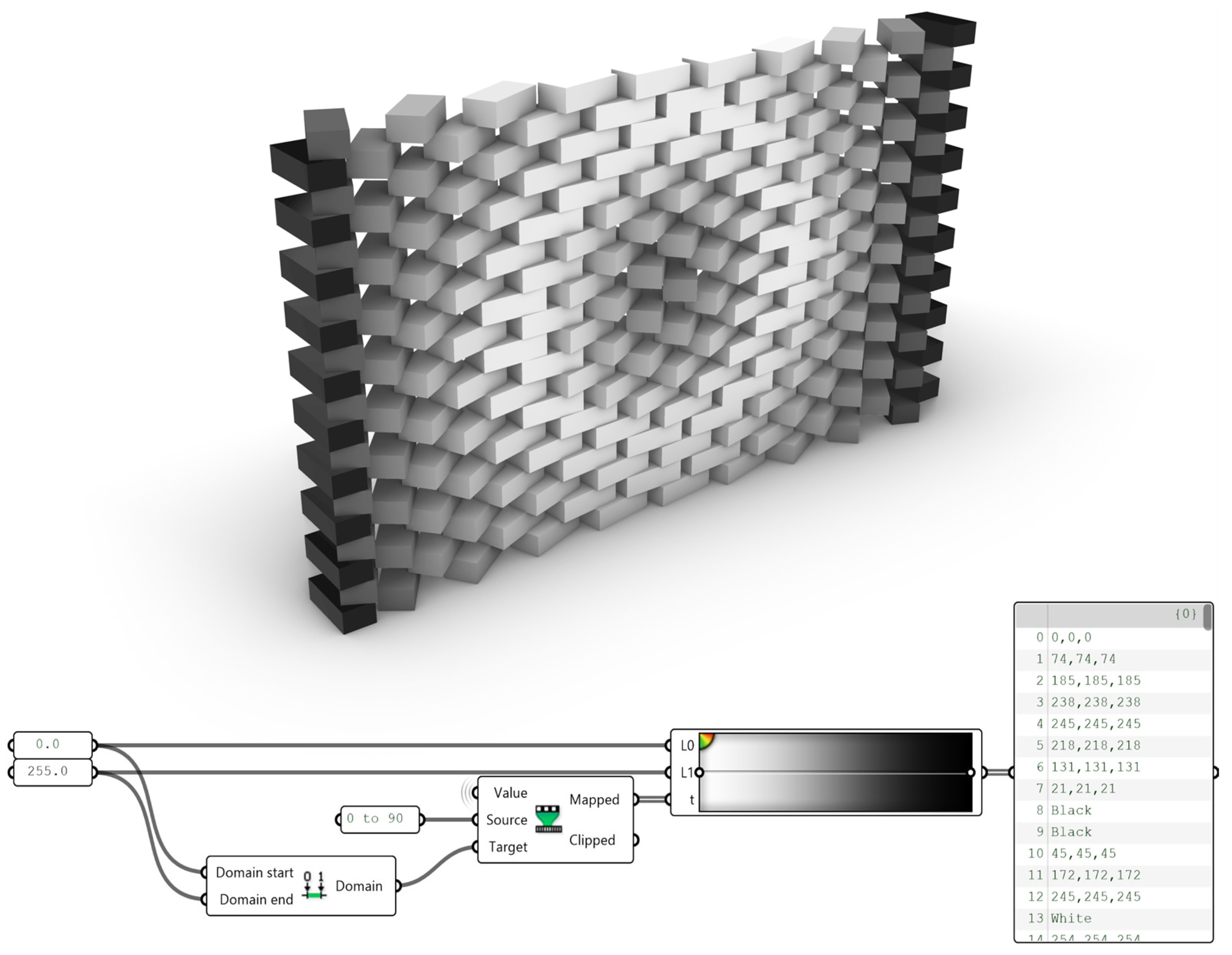



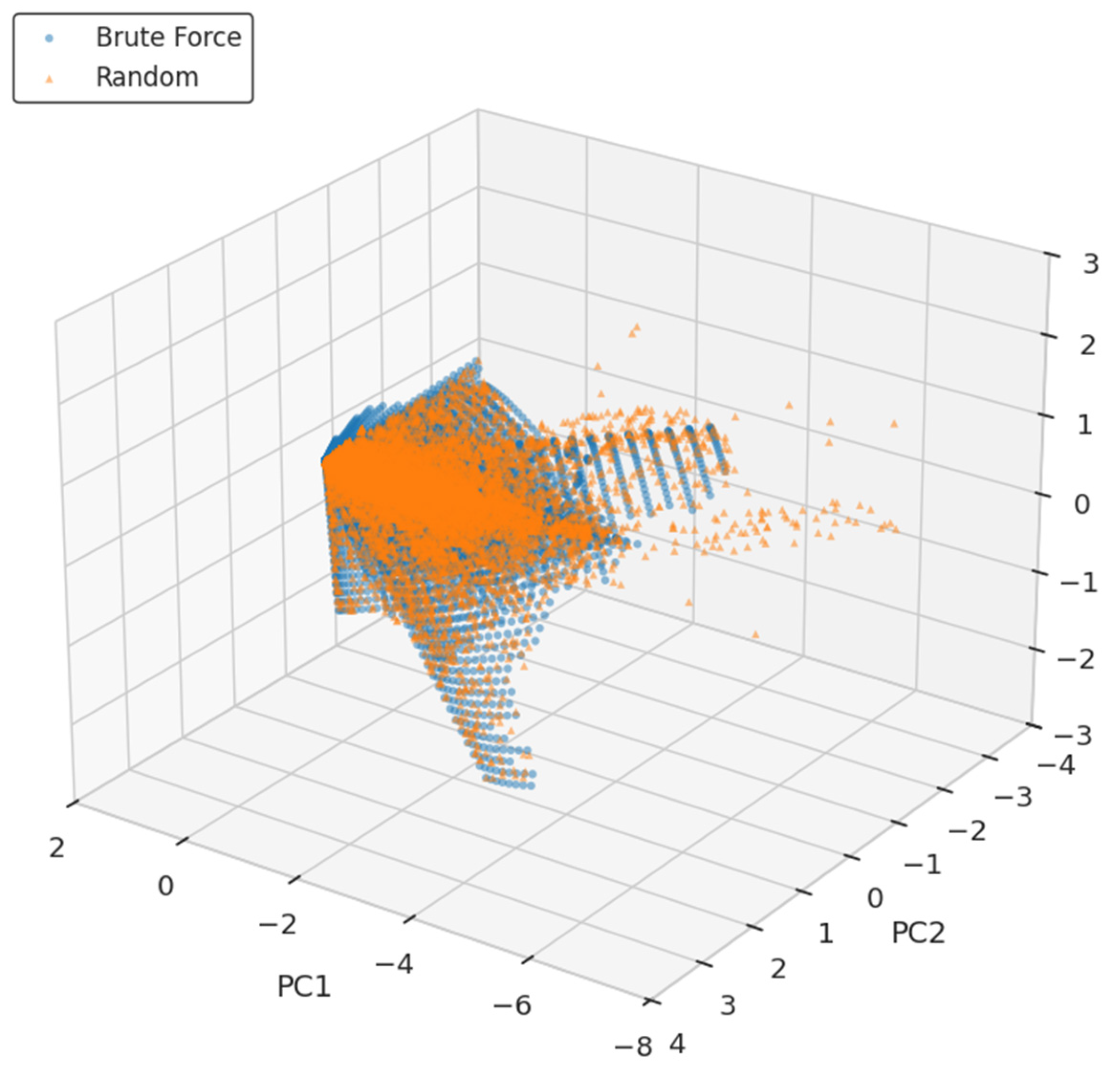
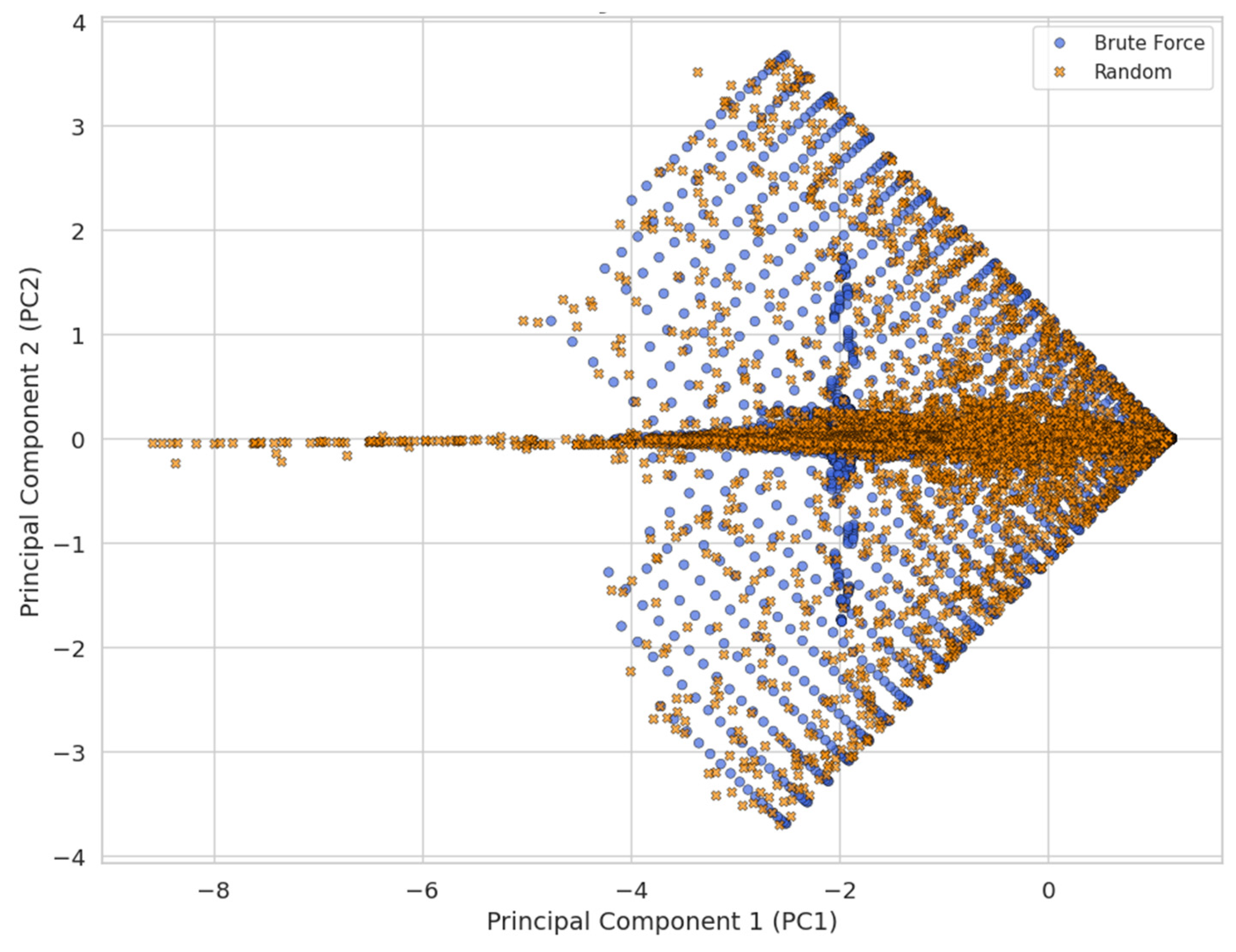
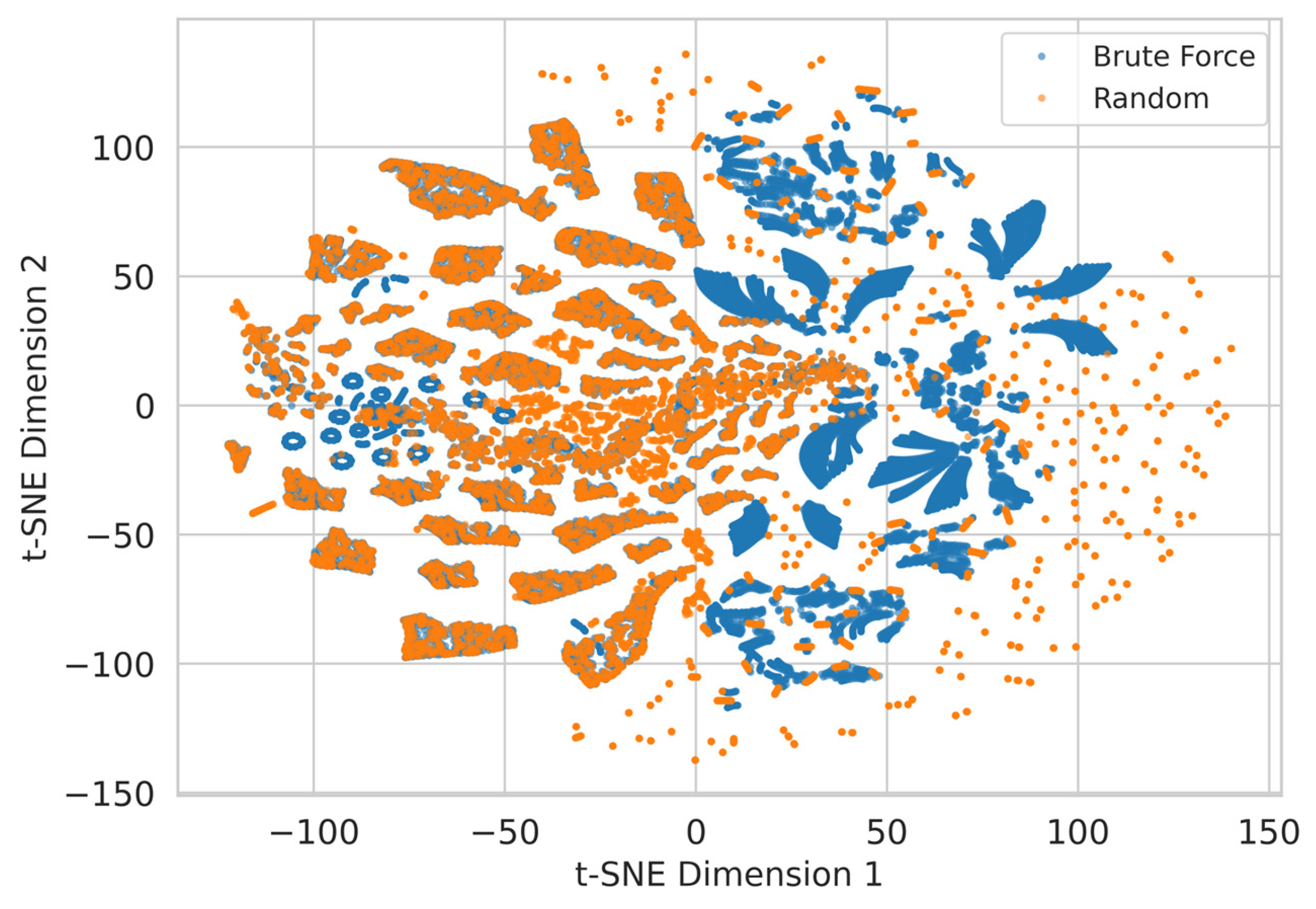
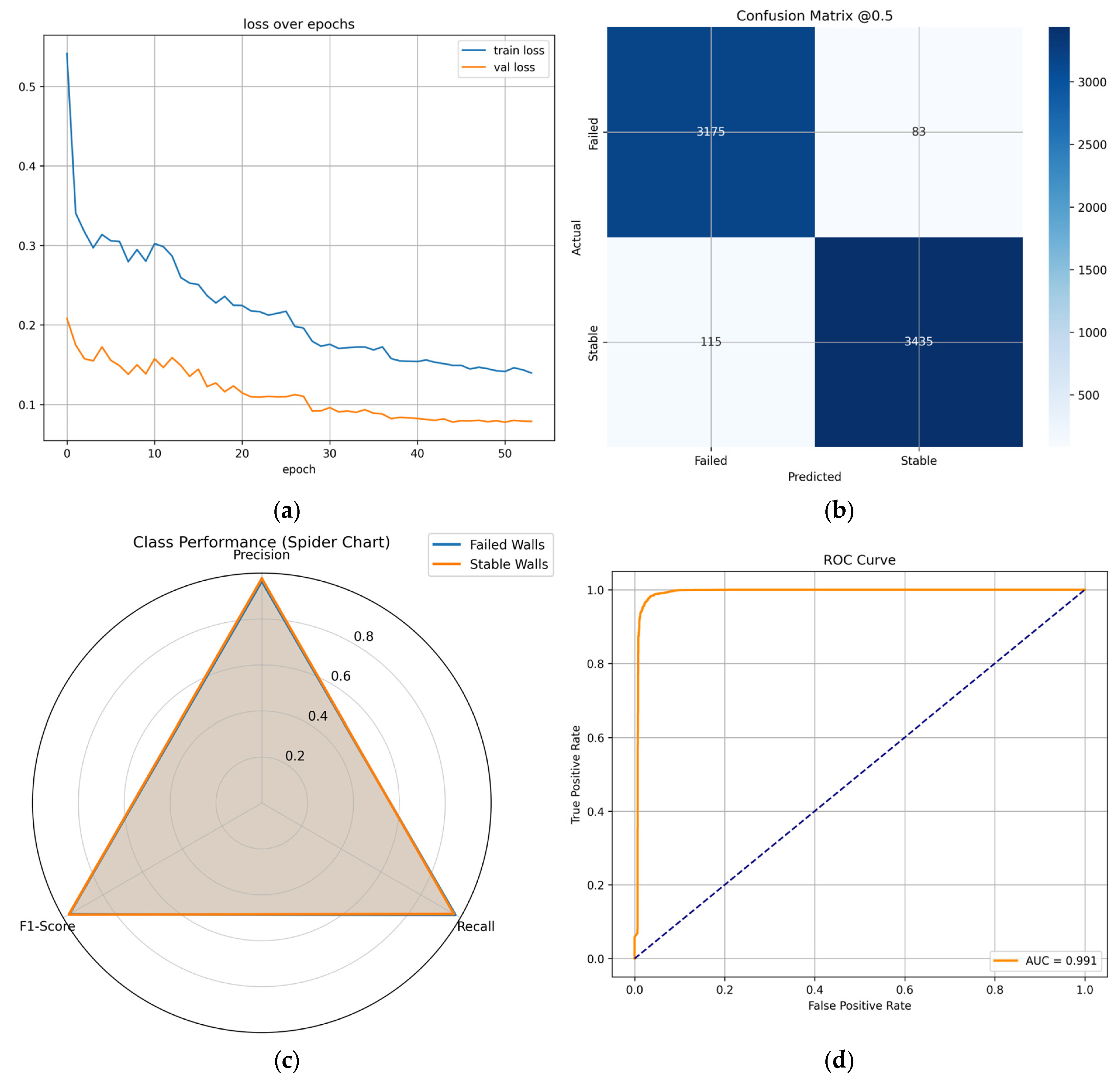

| Parameter Type | Parameter Name | Description | Status in the Model | Notes |
|---|---|---|---|---|
| Brick Wall Parameters | Brick Size | Height, Width & Length | Fixed | 38 × 115 × 55 mm (½ size of a standard Australian brick) |
| Number of bricks per bond | Defines horizontal brick count per course | Fixed | 10 bricks per bond (standardized for all designs) | |
| Number of bonds (Courses) | Defines wall height in courses | Fixed | 20 bonds in total (standardized for all designs) | |
| Bond pattern | Runner bond used throughout | Fixed | Establishes reference wall topology | |
| Brick Rotation Angles | Governs the pattern of each wall | Variable (0–90 degrees) | Varied in 2° increments (46 levels) for brute-force sampling; random sampling generated continuous values between 0–90° | |
| Fabrication Constraints | Robot Reachability | Ensures wall lies within UR10 workspace | Fixed | Limits maximum wall dimensions |
| Gripper Width | Determines grasping range | Fixed | The bricks were customized based on Robotiq 2F-85 gripper specifications | |
| Assembly sequence | Defines the pick-and-place order of bricks to ensure collision-free, feasible robot motion | Fixed | Automatically derived from brick indices; scalable to alternate sequencing strategies |
| Wall Class | Brute-Force Dataset | Random Dataset | ||||
|---|---|---|---|---|---|---|
| Passed | Failed | Total | Passed | Failed | Total | |
| Class01 | 999 (47%) | 1118 (53%) | 2117 | 1014 (48%) | 1101 (52%) | 2115 |
| Class02 | 819 (39%) | 1297 (61%) | 2116 | 831 (39%) | 1284 (61%) | 2115 |
| Class03 | 795 (38%) | 1321 (62%) | 2116 | 783 (37%) | 1333(63%) | 2116 |
| Class04 | 711 (34%) | 1405 (66%) | 2116 | 731 (35%) | 1385(65%) | 2116 |
| Class05 | 782 (37%) | 1334 (63%) | 2116 | 779 (37%) | 1337 (63%) | 2116 |
| Class06 | 787 (37%) | 1329 (63%) | 2116 | 768 (36%) | 1342 (64%) | 2116 |
| Class07 | 766 (36%) | 1350 (64%) | 2116 | 777 (37%) | 1339 (63%) | 2110 |
| Class08 | 752 (36%) | 1364 (64%) | 2116 | 874 (43%) | 1142 (57%) | 2116 |
| Class09 | 1001 (47%) | 1115 (53%) | 2116 | 928 (46%) | 1088 (54%) | 2116 |
| Class10 | 874 (41%) | 1242 (59%) | 2116 | 896 (42%) | 1220 (58%) | 2116 |
| Class11 | 3359 (74%) | 1195 (26%) | 4554 | 3182 (70%) | 1374 (30%) | 4556 |
| Class12 | 1699 (82%) | 371 (18%) | 2070 | 1586 (77%) | 484 (23%) | 2070 |
| Class13 | 1643 (79%) | 427 (21%) | 2070 | 1536 (74%) | 534 (26%) | 2070 |
| Class14 | 1659 (80%) | 411 (20%) | 2070 | 1536 (74%) | 534 (26%) | 2070 |
| Class15 | 1105 (52%) | 1011 (48%) | 2116 | 1505 (71%) | 612 (29%) | 2117 |
| Total | 17,751 (52%) | 16,290 (48%) | 34,041 | 17,726 (52%) | 16,109 (48%) | 33,835 |
Disclaimer/Publisher’s Note: The statements, opinions and data contained in all publications are solely those of the individual author(s) and contributor(s) and not of MDPI and/or the editor(s). MDPI and/or the editor(s) disclaim responsibility for any injury to people or property resulting from any ideas, methods, instructions or products referred to in the content. |
© 2025 by the authors. Licensee MDPI, Basel, Switzerland. This article is an open access article distributed under the terms and conditions of the Creative Commons Attribution (CC BY) license (https://creativecommons.org/licenses/by/4.0/).
Share and Cite
Rafizadeh, H.; Fialho Leandro Alves Teixeira, M.; Donovan, J.; Schork, T. Fabrication-Aware Synthetic Dataset Generation and Compact Geometric Encoding for Architectural Robotic Assembly of Brick Wall Designs. Buildings 2025, 15, 4041. https://doi.org/10.3390/buildings15224041
Rafizadeh H, Fialho Leandro Alves Teixeira M, Donovan J, Schork T. Fabrication-Aware Synthetic Dataset Generation and Compact Geometric Encoding for Architectural Robotic Assembly of Brick Wall Designs. Buildings. 2025; 15(22):4041. https://doi.org/10.3390/buildings15224041
Chicago/Turabian StyleRafizadeh, Hamidreza, Muge Fialho Leandro Alves Teixeira, Jared Donovan, and Tim Schork. 2025. "Fabrication-Aware Synthetic Dataset Generation and Compact Geometric Encoding for Architectural Robotic Assembly of Brick Wall Designs" Buildings 15, no. 22: 4041. https://doi.org/10.3390/buildings15224041
APA StyleRafizadeh, H., Fialho Leandro Alves Teixeira, M., Donovan, J., & Schork, T. (2025). Fabrication-Aware Synthetic Dataset Generation and Compact Geometric Encoding for Architectural Robotic Assembly of Brick Wall Designs. Buildings, 15(22), 4041. https://doi.org/10.3390/buildings15224041






